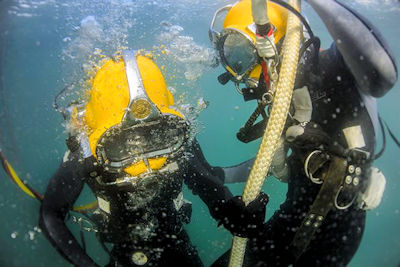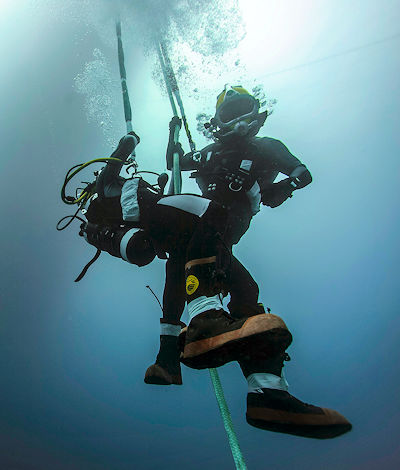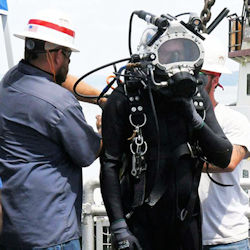30.D Surface Supplied Air (SSA) Operations.
30.D.01 SSA operations must not be conducted at depths greater than 190 ft (57.9 m) except that dives with bottom times of 30 minutes or less may be conducted to depth of 220 ft (67 m).
Exceptional exposure dives, as defined by the US Navy Diving Manual, must not be conducted except in emergency lifesaving situations. USACE in-house SSA operations must not exceed a depth of 110 ft (33.5 m) unless a waiver is requested by the DDC and approved by the HQUSACE Dive Safety Program Manager.
30.D.02 SSA equipment components must be a type specifically designed to be used in diving support systems.
30.D.03 A recompression chamber must be available for all SSA operations when diving outside the decompression limits, utilizing mixed gas, and/or when diving at or deeper than 100 ft (30.5 m) is planned.
- Under these conditions, a dual lock, multi-place, recompression chamber (capable of recompressing a diver at the surface to a depth equivalent to 165 ft (50.3 m) of sea water) must be available at the dive location and immediately available for use.
- The chamber must be of sufficient size to accommodate the diver as well as an inside tender, and a trained chamber operator must be immediately available.
- Sufficient oxygen must be available to complete chamber operations.
30.D.04 A bell must be used for dives with an in-water decompression time greater than 120 minutes, unless heavy gear is worn or diving is conducted in physically confining spaces.
30.D.05 Minimum specific operational requirements for SSA diving operations are as follows:
- Each diver must be continuously tendered while in the water, with one diver per tender, regardless of depth. The tender must not perform any other duties outside of tending the diver except as allowed by Appendix G;
- An underwater tender/diver must be stationed at the immediate underwater point of entry when any overhead obstruction limiting direct access to the surface is present and/or penetration diving is conducted or in enclosed or physically confining spaces;
- Each diving operation must have a primary breathing air supply sufficient to support divers for the duration of the planned dive, including decompression;
- Each diver must have a reserve breathing supply available that can be turned on immediately by the diver in the event of loss of air. The reserve breathing air supply must be of sufficient capacity to recover the diver and complete emergency recompression (if required) in the event of loss of primary air but no less than 30 ft3 (0.85 m3). Heavy-gear diving is exempted from these provisions because the gear carries its own reserve;
- Each dive location must have a reserve breathing air supply integral or in-line with the primary air source sufficient to safely terminate the dive and recover the diver(s) in the event of loss of the primary air supply;
- For dives deeper than 100 ft (30.5 m) or outside the no decompression limits and using heavy gear, a spare air supply hose, to replace the diver's air hose should it become damaged, must be available to the standby diver. An in-water support stage must be provided to divers in water when using heavy gear, regardless of depth;
- Electronic communication systems with an external speaker must be incorporated so the entire dive team can monitor communications.
- (1) Communications devices must be tested prior to each dive, maintained in an operable condition, and protected from damage during use and storage IAW the manufacturer's recommendations.
- (2) All dive operations will be terminated in a safe, orderly fashion using line-pull signals if voice communications are lost.
- (3) Defective electronic communication equipment must not prevent a standby diver from deploying in an emergency if the dive supervisor determines it is safe for the diver to deploy and line-pull signals are used.
Knowledge Check Choose the best answer for the question.
30-13. When can SSA operations be conducted at depths of 220 ft (67 m)?
You forgot to answer the question!



